Home » 2022 (Page 2)
Yearly Archives: 2022
Looking for a proxy of the ionospheric turbulence with Swarm data
Papers from SWICo members
P. De Michelis, G. Consolini, A. Pignalberi, R. Tozzi, I. Coco, F. Giannattasio, M. Pezzopane, and G. Balasis.
We selected about four years (April 2014-February 2018) of 1 Hz electron density measurements recorded on-board ESA Swarm A satellite, and we identified two different geomagnetic conditions according to the Auroral Electrojet (AE) index: quiet (AE<50 nT) and active (AE>300 nT). For both datasets, we evaluated the first- and second-order scaling exponents and an intermittency coefficient associated with the electron density fluctuations. Then, the joint probability distribution between each of these quantities and the rate of change of electron density index (RODI) was also evaluated.
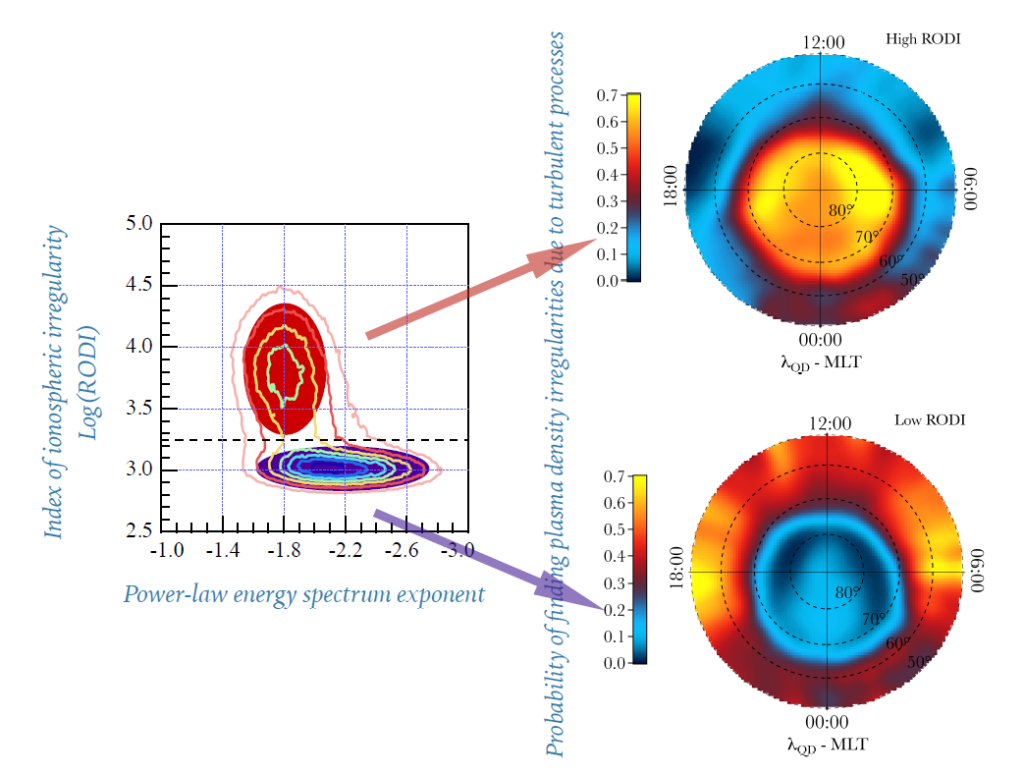
We identified two families of plasma density fluctuations characterized by different mean values of both the scaling exponents and RODI, suggesting that different mechanisms (instabilities/turbulent processes) can be responsible for the observed scaling features. Furthermore, a clear different localization of the two families in the magnetic latitude – magnetic local time plane is found and its dependence on geomagnetic activity levels is analyzed. These results may well have a bearing about the capability of recognizing the turbulent character of irregularities using a typical ionospheric plasma irregularity index as a proxy.
Publication: P. De Michelis, G. Consolini, A. Pignalberi, R. Tozzi, I. Coco, F. Giannattasio, M. Pezzopane, and G. Balasis, Looking for a proxy of the ionospheric turbulence with Swarm data, Scientific Reports, 11, 6183, 2021. https://doi.org/10.1038/s41598-021-84985-1
High-latitude polar pattern of ionospheric electron density: Scaling features and IMF dependence
Papers from SWICo members
G. Consolini, R. Tozzi, P. De Michelis, I. Coco, F. Giannattasio, M. Pezzopane, M.F. Marcucci, and G. Balasis.
We used electron density measurements over a period of 15 months from April 1, 2014 to June 30, 2015, from ESA Swarm A satellite, and computed the related 1st and 2nd order scaling exponents of the q-th order structure function.
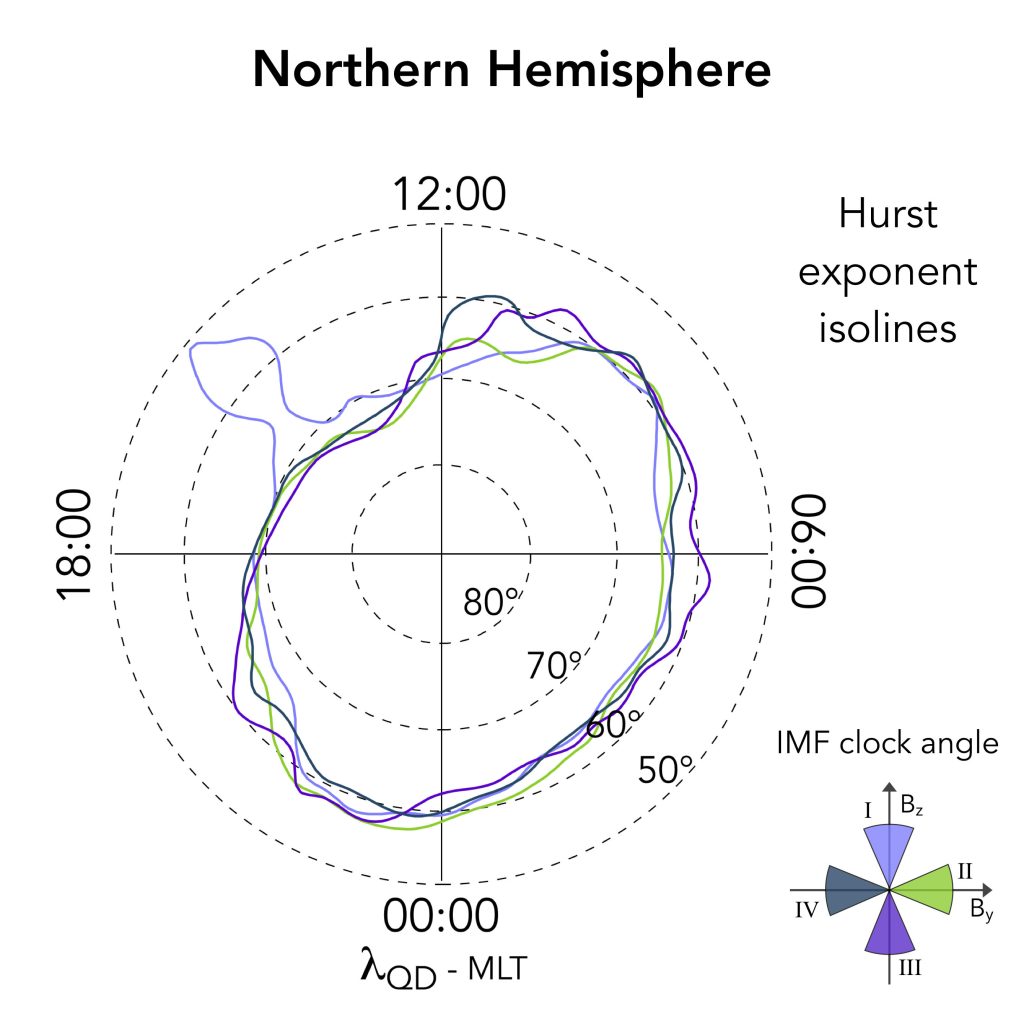
We mapped them as a function of magnetic latitude and local time for four main orientations of the Interplanetary Magnetic Field under conditions of high solar activity (average solar radio flux – F10.7 – index equal to 140 ± 30 sfu, during the considered period). On the whole, the found patterns of the electron density 1st and 2nd order scaling exponents suggest the occurrence of turbulence at the high latitudes.
Publication: G. Consolini, R. Tozzi, P. De Michelis, I. Coco, F. Giannattasio, M. Pezzopane, M.F. Marcucci, and G. Balasis, High-latitude polar pattern of ionospheric electron density: Scaling features and IMF dependence, Journal of Atmospheric and Solar-Terrestrial Physics, 2021. https://doi.org/10.1016/j.jastp.2020.105531
Parallel electrical conductivity in the topside ionosphere derived from Swarm measurements
Papers from SWICo members
F. Giannattasio, P. De Michelis, A. Pignalberi, I. Coco, G. Consolini, M. Pezzopane, and R. Tozzi.
About four years of plasma data (electron density and temperature) from the ESA Swarm A satellite has been used to compute the ionospheric electrical conductivity parallel to the geomagnetic field, with the purpose of climatologically characterize a fundamental parameter involved in the formation and evolution of the field aligned currents. Variations as a function of magnetic latitude, local time and season are examined and the average effect of particle precipitation is evaluated by subtraction of the background conductivity by using the IRI model.
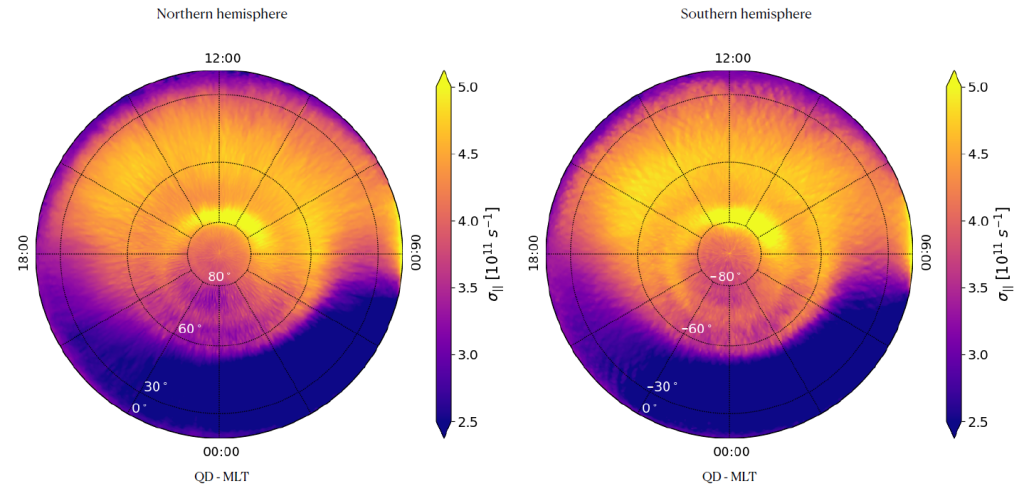
The results overall agree with previous literature, but also evidence interesting unexpected features, such as, for examples, marked asymmetries in the conductivity distributions between Northern and Southern hemispheres.
Publication: F. Giannattasio, P. De Michelis, A. Pignalberi, I. Coco, G. Consolini, M. Pezzopane, and R. Tozzi, Parallel electrical conductivity in the topside ionosphere derived from Swarm measurements, J. Geophys. Res.: Space Physics, 126(2), e2020JA028452, 2021. https://doi.org/10.1029/2020JA028452.
Forecasting SYM‐H Index: A Comparison Between Long Short‐Term Memory and Convolutional Neural Networks
Papers from SWICo members
F. Siciliano G. Consolini, R. Tozzi, M. Gentili, F. Giannattasio, and P. De Michelis.
Geomagnetic indices are proxies of the geomagnetic disturbances observed on the ground during geomagnetic storms and substorms. So, their forecasting represents a key point to develop warning systems for the mitigation of possible effects of severe geomagnetic storms on critical ground infrastructures. Here, we forecast SYM‐H index using two artificial neural network models based on two conceptually different networks: the Long Short‐Term Memory (LSTM) and the Convolutional Neural Network (CNN). Both networks are trained with two different sets of data: 1) interplanetary magnetic field (IMF) components and magnitude, and 2) interplanetary magnetic field components and magnitude and previous SYM‐H values. Specifically, we selected 42 geomagnetic storms among the most intense occurred between 1998 and 2018.
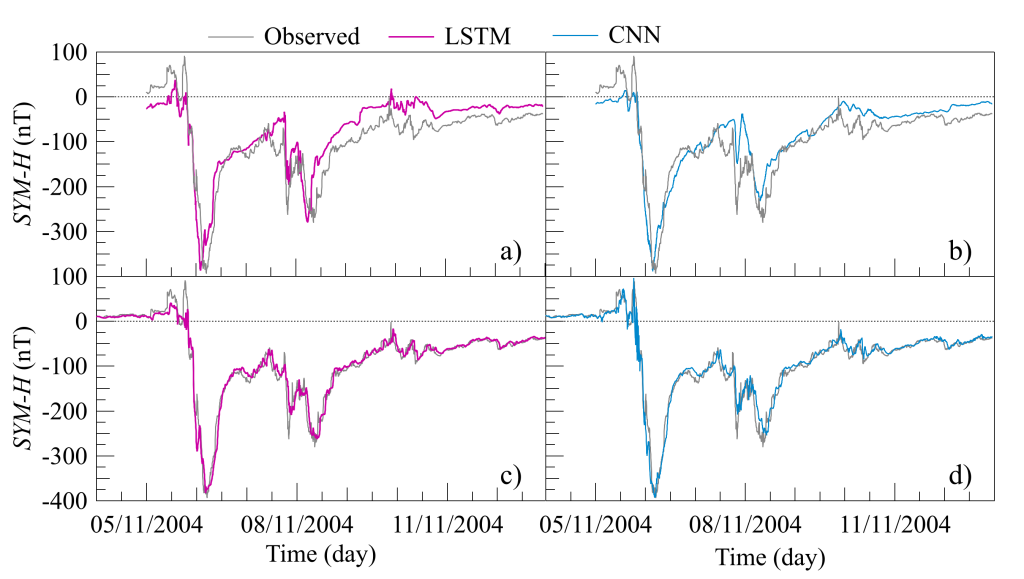
The performance of the two models has been compared thus pointing out the peculiarity of each model. In summary we have found that: 1) both networks are able to well forecast SYM‐H index 1 hour in advance, with values of the coefficient of determination R2 larger than 95%; 2) when using the data set that includes SYM-H index the model based on LSTM is slightly more accurate than that based on CNN; 3) differently, when using the data set consisting of IMF values only the model based on CNN displays a higher accuracy than that based on LSTM.
Publication: F. Siciliano G. Consolini R. Tozzi M. Gentili F. Giannattasio P. De Michelis, Forecasting SYM‐H Index: A Comparison Between Long Short‐Term Memory and Convolutional Neural Networks, Space Weather, 19 (2), 2021. https://doi.org/10.1029/2020SW002589
The Shipwreck of the Airship “Dirigibile Italia” in the 1928 Polar Venture: A Retrospective Analysis of the Ionospheric and Geomagnetic Conditions
Papers from SWICo members
B. Zolesi, M. Pezzopane, C. Bianchi, A. Meloni, Lj. R. Cander, and R. Tozzi.
On 25 May 1928, while coming back to the base in NyAlesund after having overflew the North Pole, the airship “Dirigibile Italia” shipwrecked on the ice‐pack in a region at about 400 km northeast of Svalbard Islands. Using a portable high frequency (HF) radio transmitter, survivors tried to send SOS messages and to establish a radio link with a ship closely anchored at King’s Bay, that is “Città di Milano” of the Italian Navy. All their attempts proved unsuccessful until a Russian radio amateur close to the town of Arkhangelsk about 1,900 km away succeeded in receiving the messages launched by the survivors and raised the alarm. This however happened only after 9 days of repeated radio‐distress transmissions.
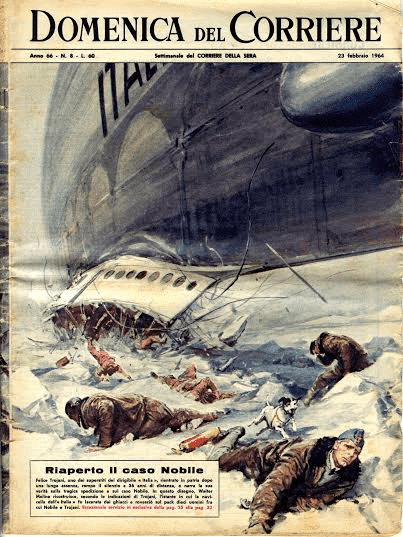
This work provides a retrospective analysis of the ionospheric and geomagnetic conditions of those days to try to explain the HF radio communications problems experienced by the survivors. To this purpose, the International Reference Ionosphere model has been used, and early geomagnetic measurements have been analysed. We found that the HF transmission difficulties were associated with the “dead zone” of F‐region propagation but that they might have been exacerbated by solar and geomagnetically disturbed conditions of the days soon after the airship wreck.
Publication: B. Zolesi, M. Pezzopane, C. Bianchi, A. Meloni, Lj. R. Cander, and R. Tozzi, The Shipwreck of the Airship “Dirigibile Italia” in the 1928 Polar Venture: A Retrospective Analysis of the Ionospheric and Geomagnetic Conditions, Space Weather, 18, e2020SW002459, 2020. https://doi.org/10.1029/2020SW002459
The ESA Swarm mission to help ionospheric modeling: a new NeQuick topside formulation for mid-latitude regions
Papers from SWICo members
M. Pezzopane and A. Pignalberi.
The ionospheric topside representation made by the NeQuick model is improved by correcting the H0 parameter. This task is accomplished by fitting the NeQuick topside analytical function through the F2-layer absolute electron density maximum and the electron density value as measured by Swarm satellites from December 2013 to September 2018. The new NeQuick formulation is statistically validated by comparing modeled values to those derived from COSMIC/FORMOSAT-3 measured Radio Occultation profiles, and those measured by Swarm satellites.
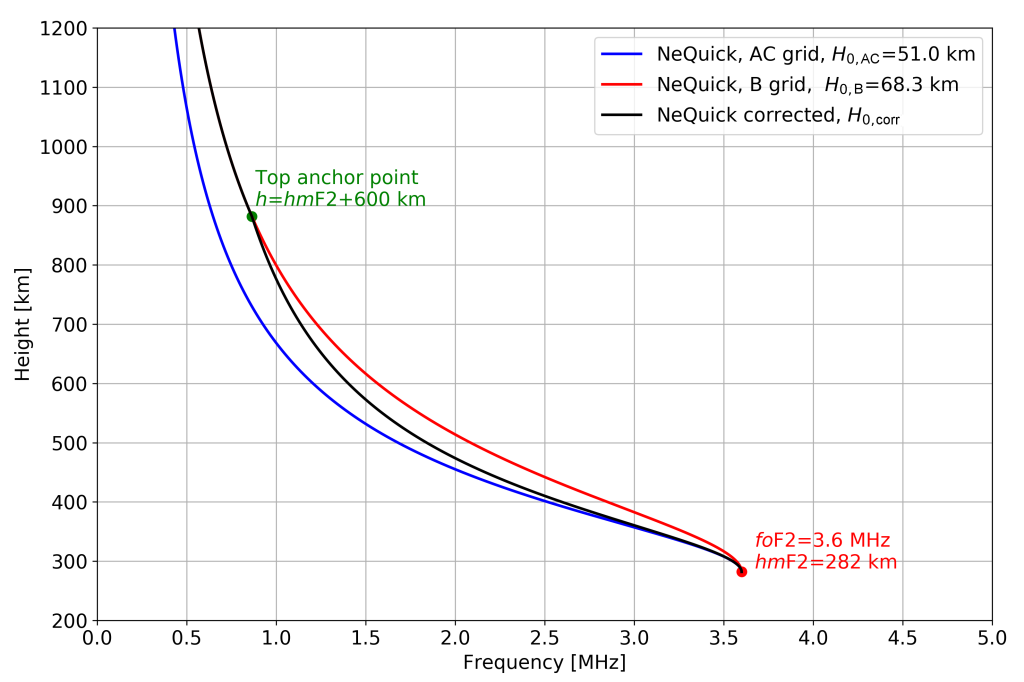
The results show that the proposed formulation is reliable and significantly improves the topside description made by the NeQuick model at mid latitudes, for both high and low solar activities. This means that this new formulation might be proposed as an additional topside option for the International Reference Ionosphere model.
Publication: M. Pezzopane and A. Pignalberi, The ESA Swarm mission to help ionospheric modeling: a new NeQuick topside formulation for mid-latitude regions, Scientific Reports, 9, 12253, 2019. https://doi.org/10.1038/s41598-019-48440-6
Maximum usable frequency and skip distance maps over Italy
Papers from SWICo members
M. Pietrella and M. Pezzopane.
This work describes how MUF and skip distance maps are generated combining the Simplified Ionospheric Regional Model (SIRM) and its UPdated version (SIRMUP) with the Lockwood algorithm. Climatological maps are generated every hour considering the predicted 12-months smoothed sunspots number. Nowcasting maps are instead generated every 15 min exploiting foF2 and M(3000)F2 data measured at the ionospheric stations of Rome and Gibilmanna.
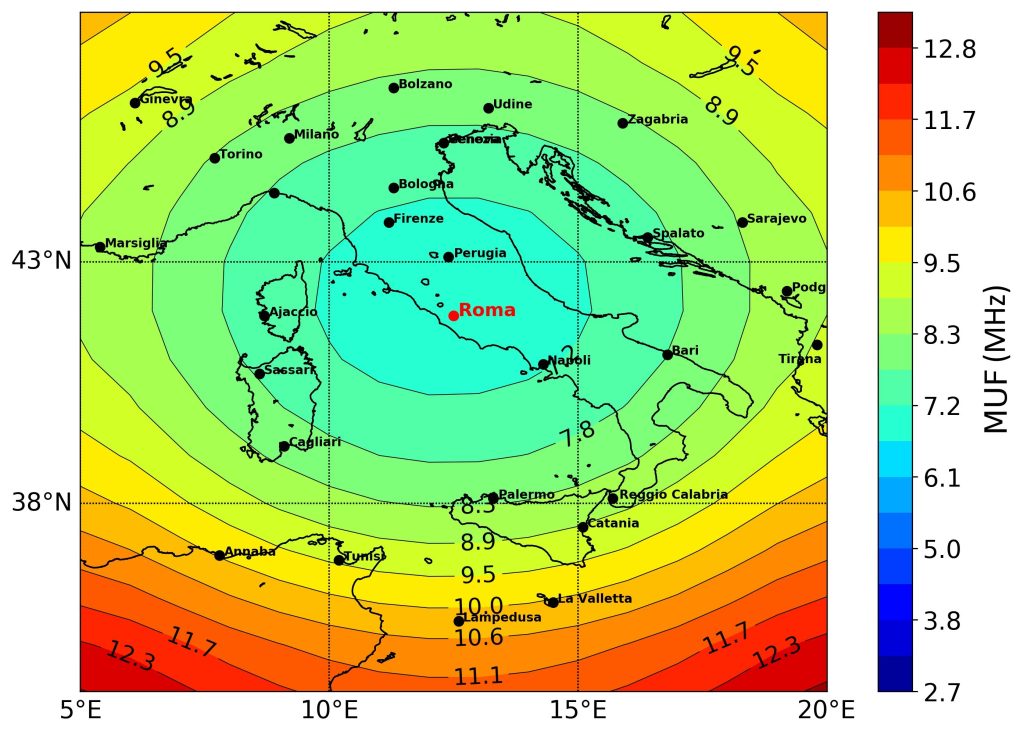
Nowcasting maps constitute the most important novelty because they let High Frequency (HF) users know in quasi real-time the radio propagation conditions over Italy. This is really important in terms of reliable radio links, especially in case of adverse space weather events.
Publication: M. Pietrella and M. Pezzopane, Maximum usable frequency and skip distance maps over Italy, Adv. Space Res., 66(2), 243, 2020. https://doi.org/10.1016/j.asr.2020.03.040
On the identification of coherent structures in space plasmas: the magnetic helicity-PVI method
Papers from SWICo members
F. Pecora, S. Servidio, A. Greco, W. H. Matthaeus
Plasma turbulence can be viewed as a magnetic landscape populated by large- and small-scale coherent structures. In this complex network, large helical magnetic tubes might be separated by small-scale magnetic reconnection events (current sheets). However, the identification of these magnetic structures in a continuous stream of data has always been a challenging task.
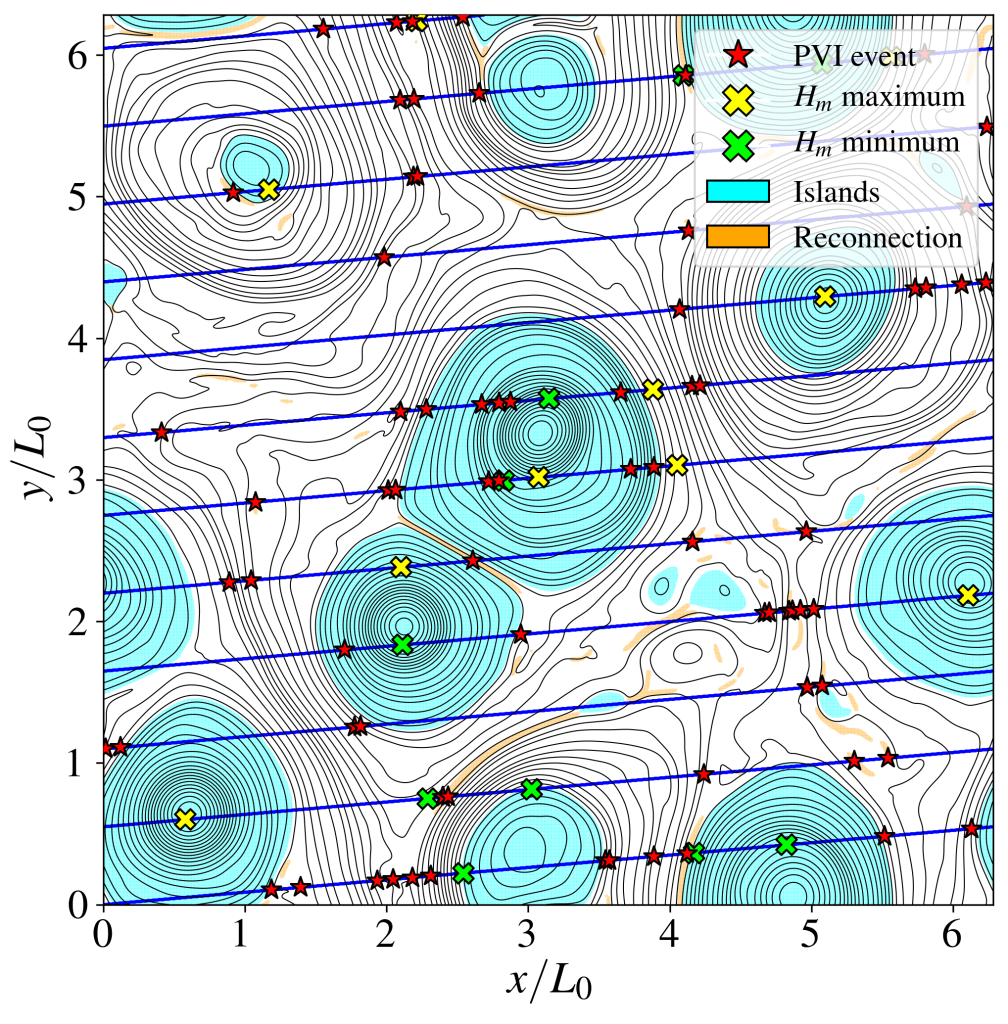
Here we present a method that is able to characterize both the large and small scale structures of the turbulent solar wind, based on the combined use of a filtered magnetic helicity (H_m) and the Partial Variance of Increments (PVI).
This simple, single-spacecraft technique, has been validated first via direct numerical simulations of plasma turbulence and then applied to data from the Parker Solar Probe (PSP) mission.
This novel analysis, combining H_m~PVI methods, reveals that a large number of flux tubes populate the solar wind and continuously merge in contact regions where magnetic reconnection and particle acceleration may occur.
Publication: Pecora F., Servidio S., Greco A., Matthaeus W.~H., 2021, A\&A, 650, A20. doi:10.1051/0004-6361/202039639. https://www.aanda.org/component/article?access=doi&doi=10.1051/0004-6361/202039639
Iniziato il secondo congresso SWICo
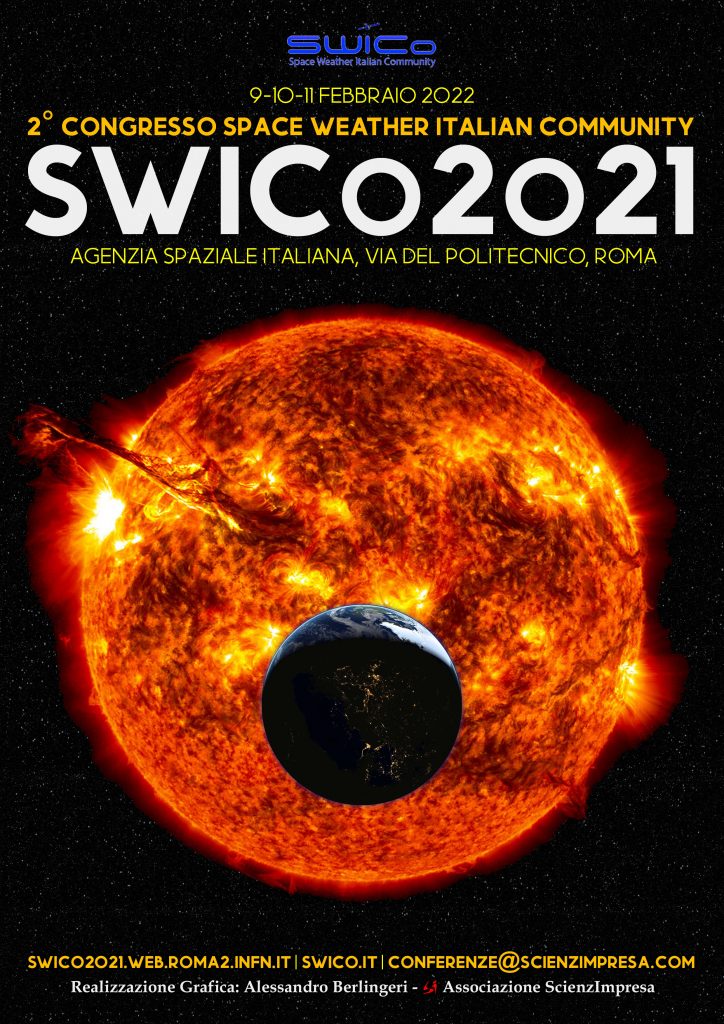
E’ iniziato oggi, 9 febbraio 2022 il “Secondo Congresso Nazionale SWICo” presso la sede ASI di Roma. L’incontro della comunità proseguirà nei giorni 9, 10 e 11 febbraio 2022 (https://swico2021.web.roma2.infn.it/). Il Congresso sarà momento di incontro e confronto dell’intera comunità eliogeofisica italiana impegnata nelle discipline relative allo Space Weather (dal Sole all’interno della Terra). E’ pertanto aperto anche a ricercatori e tecnologi non aderenti a SWICo ed è particolarmente incoraggiata la partecipazione attiva di studenti, dottorandi e giovani ricercatori.
Durante il convegno si terrà anche l’Assemblea Nazionale SWICo per il rinnovo degli Organi Statutari.
Il Congresso offrirà anche l’opportunità del conferimento del Premio “Franco Mariani” (https://swico2021.web.roma2.infn.it/premio-mariani), istituito per onorare la memoria di una personalità scientifica di statura internazionale e rivolto a giovani laureati magistrali in discipline inerenti lo “Space Weather”.
Per ulteriore informazioni sul congresso SWICo raccomandiamo la lettura delle interviste uscite nei giorni scorsi:
https://www.dire.it/07-02-2022/705540-space-weather-il-pericolo-che-viene-dal-sole-%EF%BF%BC/
Quando il Sole fa i capricci

E’ stato recentemente pubblicato un libro divulgativo dedicato allo Space Weather scritto dal Prof. Umberto Villante: Quando il Sole fa i capricci (ed. Dedalo).
Blackout, interruzioni nelle comunicazioni, traffico aereo in tilt, animali e navigatori che perdono la bussola, satelliti fuori uso, pericoli per gli astronauti: le tempeste solari sono sempre esistite, ma oggi il loro impatto sulla nostra società tecnologica può essere devastante. La giovane disciplina denominata space weather, meteorologia spaziale, studia proprio i capricci del Sole e i loro effetti sul nostro pianeta. Villante, tra i massimi esperti del settore, ci guida in modo chiaro e originale nella storia e negli attuali programmi di studio internazionali su queste tematiche, permettendoci di capire a che punto siamo nella comprensione e nella previsione di tali fenomeni. Tra aurore polari, tempeste magnetiche e possibili ripercussioni su milioni di persone, dobbiamo oggi chiederci che tempo farà sul Sole domani.




